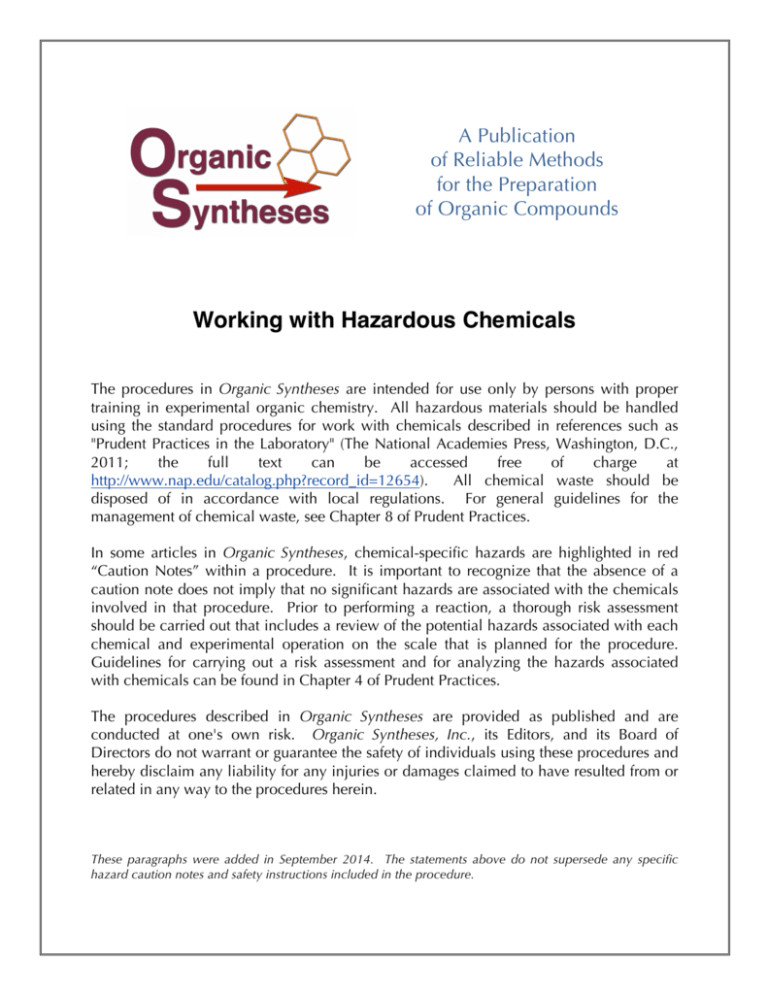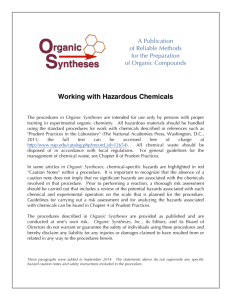
A Publication
of Reliable Methods
for the Preparation
of Organic Compounds
Working with Hazardous Chemicals
The procedures in Organic Syntheses are intended for use only by persons with proper
training in experimental organic chemistry. All hazardous materials should be handled
using the standard procedures for work with chemicals described in references such as
"Prudent Practices in the Laboratory" (The National Academies Press, Washington, D.C.,
2011;
the
full
text
can
be
accessed
free
of
charge
at
http://www.nap.edu/catalog.php?record_id=12654).
All chemical waste should be
disposed of in accordance with local regulations. For general guidelines for the
management of chemical waste, see Chapter 8 of Prudent Practices.
In some articles in Organic Syntheses, chemical-specific hazards are highlighted in red
“Caution Notes” within a procedure. It is important to recognize that the absence of a
caution note does not imply that no significant hazards are associated with the chemicals
involved in that procedure. Prior to performing a reaction, a thorough risk assessment
should be carried out that includes a review of the potential hazards associated with each
chemical and experimental operation on the scale that is planned for the procedure.
Guidelines for carrying out a risk assessment and for analyzing the hazards associated
with chemicals can be found in Chapter 4 of Prudent Practices.
The procedures described in Organic Syntheses are provided as published and are
conducted at one's own risk. Organic Syntheses, Inc., its Editors, and its Board of
Directors do not warrant or guarantee the safety of individuals using these procedures and
hereby disclaim any liability for any injuries or damages claimed to have resulted from or
related in any way to the procedures herein.
These paragraphs were added in September 2014. The statements above do not supersede any specific
hazard caution notes and safety instructions included in the procedure.
DOI:10.15227/orgsyn.011.0076
Organic Syntheses, Coll. Vol. 2, p.416 (1943); Vol. 11, p.76 (1931).
3-METHYLPENTANOIC ACID
[Valeric acid, β-methyl-]
Submitted by E. B. Vliet, C. S. Marvel, and C. M. Hsueh.
Checked by Henry Gilman and R. E. Brown.
1. Procedure
A solution of 200 g. (3.6 moles) of potassium hydroxide (Note 1) in 200 cc. of water is placed in a
2-l. round-bottomed flask fitted with a reflux condenser, a mechanical stirrer, and a separatory funnel.
The stirrer is started, and to the hot solution 200 g. (0.92 mole) of ethyl sec.-butylmalonate (Note 2) is
added slowly. The solution refluxes quietly owing to the heat of saponification. After all the sec.butylmalonic ester has been added, the solution is boiled gently for two hours. It is then diluted with 200
cc. of water, and 200 cc. of liquid is distilled from the solution in order to remove all the alcohol formed
during the saponification (Note 3).
The residual liquid in the flask is allowed to cool, and a cold solution of 320 g. (3.3 moles) of
concentrated sulfuric acid (Note 4) in 450 cc. of water is added through the separatory funnel. This
should be done slowly and with stirring in order to prevent foaming. The solution becomes hot and may
reflux spontaneously. After all the sulfuric acid has been added the solution is refluxed for about three
hours. A layer of organic acid appears and the reflux condenser is replaced by an automatic separator
(Note 5). The solution is distilled with the separator attached, and the aqueous portion is returned to the
distilling flask. This operation is continued until practically all the organic acid has been driven over;
from ten to fifteen hours is required. At the end, about 100 cc. of water is collected in the separator and
extracted with ether in order to remove the dissolved acid (Note 6). The ether is distilled; the crude acid
is mixed with an equal volume of dry benzene (Note 7) and distilled from a modified Claisen flask with
a fractionating side arm. Benzene and water distil first and then 3-methylpentanoic acid distils at 193–
196°/743 mm. The yield is 66–69 g. (62–65 per cent of the theoretical amount) (Note 8).
2. Notes
1. Sodium hydroxide is unsatisfactory for this saponification because an organic sodium salt separates,
yielding a semi-solid mass.
2. The ethyl sec.-butylmalonate was prepared from sec.-butyl bromide and malonic ester according to
the general method described in Org. Syn. Coll. Vol. I, 1941, 250. The yield of ester boiling at 124–
132°/28 mm. was 80–81 per cent of the theoretical amount. The yields of 3-methylpentanoic acid given
in this procedure were obtained with this grade of ester.
3. It is necessary that all the alcohol be eliminated after the saponification. If some is allowed to remain,
ethyl 3-methylpentanoate is formed and a considerable amount of low-boiling material is present in the
final product.
4. If hydrochloric acid is used, it distils and complicates the purification of the product.
5. The apparatus shown in Org. Syn. Coll. Vol. I, 1941, 422, Fig. 22, was found to be very effective.
Other methods of isolating the acid were not so satisfactory. When extraction with a solvent was used,
the yield was about 10 per cent less and the product was contaminated with tarry impurities.
6. The amount of acid recovered by the ether extraction is only 1–2 g.
7. The acid may be dried by other means, but this method was found most convenient.
8. Other acids may be prepared by this general procedure; thus n-caproic acid may be obtained from
ethyl n-butylmalonate in 75 per cent yield.
3. Discussion
3-Methylpentanoic acid has been prepared by heating sec.-butylmalonic acid,1 and by the addition
of ethylmagnesium bromide to the N-methylanilide of crotonic acid, followed by hydrolysis.2
This preparation is referenced from:
z
Org. Syn. Coll. Vol. 2, 474
References and Notes
1. Van Romburgh, Rec. trav. chim. 6, 153 (1887); Kulisch, Monatsh. 14, 559 (1893); Bentley, J.
Chem. Soc. 67, 267 (1895); Olivier, Rec. trav. chim. 55, 1032 (1936).
2. Maxim and Ioanid, Bul. Soc. Chim. România 12, (1930) [C. A. 25, 488 (1931)].
Appendix
Chemical Abstracts Nomenclature (Collective Index Number);
(Registry Number)
Malonic Ester
N-methylanilide of crotonic acid
sec.-butylmalonic ester
sulfuric acid (7664-93-9)
hydrochloric acid (7647-01-0)
Benzene (71-43-2)
ether (60-29-7)
sodium hydroxide (1310-73-2)
sec.-BUTYL BROMIDE (78-76-2)
potassium hydroxide (1310-58-3)
n-caproic acid (142-62-1)
ETHYL n-BUTYLMALONATE
ethylmagnesium bromide (925-90-6)
3-Methylpentanoic acid,
Valeric acid, β-methyl- (105-43-1)
ethyl 3-methylpentanoate (5870-68-8)
ethyl sec.-butylmalonate
sec.-butylmalonic acid
Copyright © 1921-2005, Organic Syntheses, Inc. All Rights Reserved






